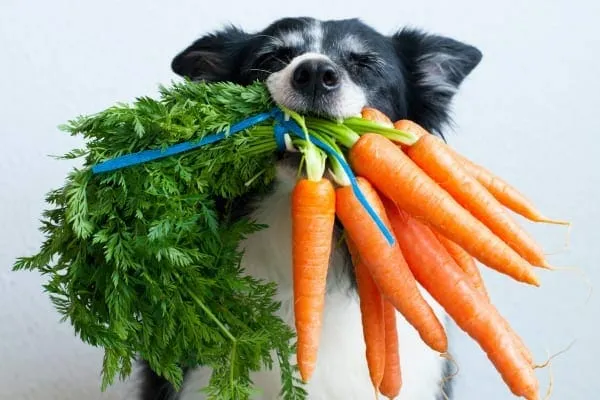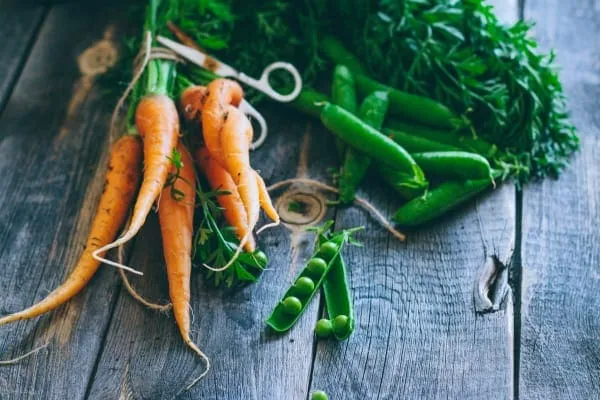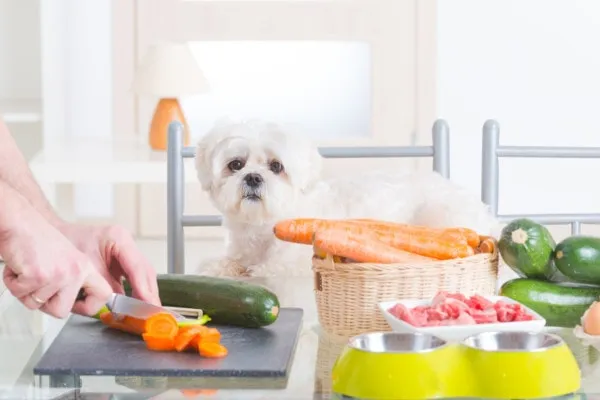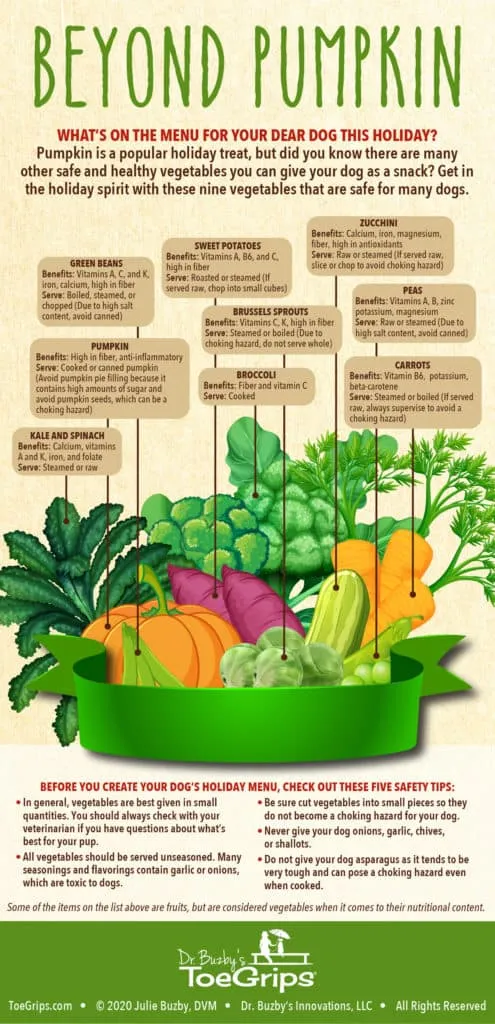Vegetables dogs can eat offer a fantastic way to boost your pup’s health with low-calorie, nutrient-packed treats. From crunchy carrots to fiber-rich pumpkin, many veggies provide benefits like weight management, better digestion, and immune support. As an integrative veterinarian like Dr. Julie Buzby often recommends, incorporating safe vegetables into your dog’s diet can be a game-changer, especially for overweight, diabetic, or senior dogs. But not all human veggies are dog-friendly—some pose serious risks.
Wondering what vegetables dogs can t eat? Always prioritize safety by sticking to vet-approved options and preparing them properly. This guide covers 14 top vegetables dogs can eat, their benefits, preparation tips, and four to steer clear of entirely.
 Dog holding carrots, a vegetable most dogs can eat, in his mouth
Dog holding carrots, a vegetable most dogs can eat, in his mouth
Benefits of Vegetables for Dogs
Adding vegetables dogs can eat to your furry friend’s meals goes beyond treats—they’re a smart supplement for overall wellness. Here’s why they’re so valuable:
- Weight Management: Low-calorie veggies like green beans help overweight dogs feel full without extra calories. A “green bean diet” addition to meals curbs hunger effectively.
- Digestive Health: High fiber content supports gut motility, prevents constipation, and aids anal gland function.
- Immune Boost: Vitamins like C and A strengthen defenses against illness.
- Blood Sugar Control: Ideal for diabetic dogs, as they stabilize glucose levels.
- Antioxidants: Combat disease risk and promote longevity.
- Training Treats: Crunchy options like carrots motivate during sessions without packing on pounds.
These perks make vegetables dogs can eat essential, drawing from veterinary expertise to ensure balanced nutrition.
Top 14 Vegetables Dogs Can Eat
Here’s a curated list of safe, nutritious choices. Always introduce new veggies gradually and limit treats to 10% of daily calories.
1. Pumpkin
Pumpkin tops the list of vegetables dogs can eat for its fiber punch. It firms up loose stools or eases constipation by absorbing water or bulking waste. Plus, its linoleic acid (an omega-6) soothes skin inflammation.
Opt for plain canned or cooked pumpkin—avoid pie filling with sugar and spices. Start with 1-2 tablespoons mixed into meals. Stool may turn orange temporarily, which is harmless.
 Little dog sitting at table waiting to eat a vegetable.
Little dog sitting at table waiting to eat a vegetable.
Pumpkin shines for seniors with chronic soft stools.
2. Broccoli
This cruciferous veggie delivers fiber and vitamin C for immunity. Serve cooked (no seasonings) or small raw florets for crunch—perfect low-cal snacks.
Limit portions to avoid gas or esophageal irritation. Chop finely for small breeds to prevent choking.
3. Carrots
Carrots, a classic among vegetables dogs can eat, provide beta-carotene for vitamin A production, supporting vision and immunity. They’re rich in potassium and B6 too.
Raw for crunch, steamed or boiled for softness—1 oz is just 10 calories. Ideal for weight loss, but skip for diabetics due to natural sugars. Supervise to avoid choking.
 Owner giving her dog a carrot, one of the vegetables dogs can eat.
Owner giving her dog a carrot, one of the vegetables dogs can eat.
4. Green Beans
Packed with vitamins A, C, K, iron, and calcium, green beans aid diabetes management and satiety on low-cal diets.
Boil, steam, or chop fresh—skip salted canned versions. Begin with 2-3 beans daily.
For more on safe produce, check what human vegetables can dogs eat.
5. Kale and Spinach
These leafy greens offer calcium for bones, vitamin K for clotting, vitamin A for eyes, iron for oxygen transport, and folate for nutrient absorption.
Steam or shred raw leaves into meals. Moderation is key—excess calcium risks bladder stones in prone dogs. Consult your vet.
 Happy beagle dog waiting for a vegetable treat.
Happy beagle dog waiting for a vegetable treat.
6. Brussels Sprouts
High in fiber, vitamins C and K, and magnesium for muscle health. Steam or boil, cut small to dodge choking or gas.
Start with 1-2 pieces.
7. Zucchini
Supports GI health with calcium, iron, magnesium, and fiber. Raw or steamed slices (3-4 at a time)—no seasonings, as garlic/onions or xylitol dressings are toxic.
8. Sweet Potatoes
Vitamins A, B6, C, and fiber make them tasty. Cube raw or steam/roast. High sugar means no-go for diabetics or overweight pups.
9. Peas
Snow or sugar peas bring vitamins A/B, potassium, magnesium, and zinc for immunity. Steam/boil—a 1-oz serving is 20 calories. Avoid canned salt and purine-heavy for kidney issues.
 Carrots and vegetables dogs can eat laid out on a table.
Carrots and vegetables dogs can eat laid out on a table.
10. Corn
Kernel-only (no cob!) provides digestible carbs, linoleic acid for skin/coat, and fiber. Steam plain.
Beware cobs cause blockages needing surgery.
11. Celery
Low-cal, fat-free crunch. Wash raw thoroughly—may not appeal to all picky eaters.
12. Cooked White Potatoes
Post-cooking, they’re safe with vitamin C, B6, iron, magnesium. Raw solanine is toxic—causes vomiting.
13. Cauliflower
Fiber, vitamins K/A/C, beta-carotene, antioxidants, minerals. Bite-sized raw or cooked—limit to prevent choking/upset.
14. Beets
Antioxidant powerhouses with folate, fiber, vitamin C for skin/coat. Temporary pink urine is normal; persistent color warrants a vet check.
 Little white dog sitting at the table while owner cuts up vegetables including carrots
Little white dog sitting at the table while owner cuts up vegetables including carrots
While many vegetables dogs can eat are beneficial, others like those in the Allium family spell danger. See what fruits and vegetables can dogs not eat for details.
Vegetables Dogs Should Never Eat
Avoid these entirely:
- Onions, Garlic, Chives, Shallots: Damage red blood cells—seek emergency vet care.
- Mushrooms: Risk diarrhea to liver failure; wild ones are unpredictable.
- Unripe Tomatoes: Nightshade toxins cause GI upset, lethargy.
- Choking Hazards: Always size-appropriate.
 Infographic showing 10 healthy vegetables dogs can eat along with the benefits of each one. List includes veggies like green beans and carrots
Infographic showing 10 healthy vegetables dogs can eat along with the benefits of each one. List includes veggies like green beans and carrots
How to Prepare Vegetables Dogs Can Eat
Preparation maximizes safety and appeal:
- Raw: Wash meticulously for baby carrots/celery. Crisp rewards.
- Steamed: Nutrient-preserving; chop uniformly, cool before serving.
- Boiled: Softest for toothless seniors; nutrient loss minimal if timed right.
Creative twists: Puree for mixing, freeze for summer chews. Experiment—your dog might prefer steamed over raw.
 Yellow Labrador dog standing on his hind legs waiting for a vegetable treat.
Yellow Labrador dog standing on his hind legs waiting for a vegetable treat.
Explore what fruits and veggies can dogs not eat and what vegetables can dogs not eat to round out your knowledge.
Final Thoughts on Vegetables Dogs Can Eat
Vegetables dogs can eat enhance diets with fiber, vitamins, and fun—perfect alongside quality kibble. Test favorites cautiously, consult vets for health-specific advice, and never exceed treat limits. Your pup’s tail-wagging thanks (and healthier body) await!
Share your dog’s veggie faves in the comments—what’s their go-to crunch? For more tips, browse our dog care guides.
